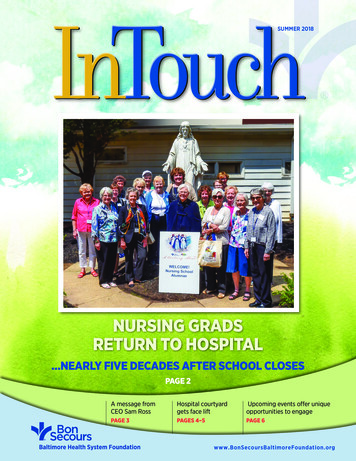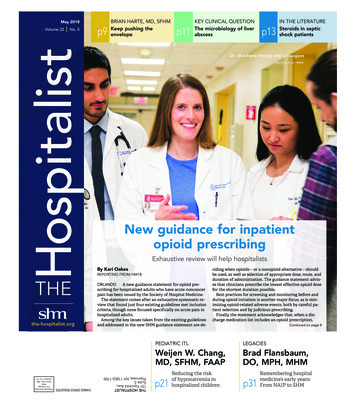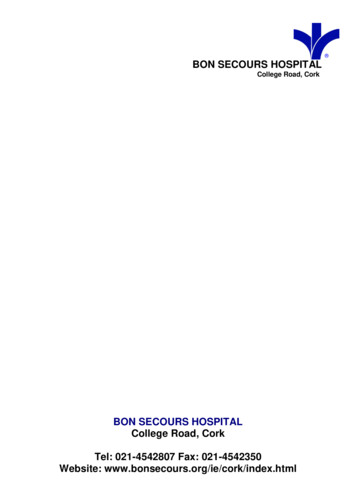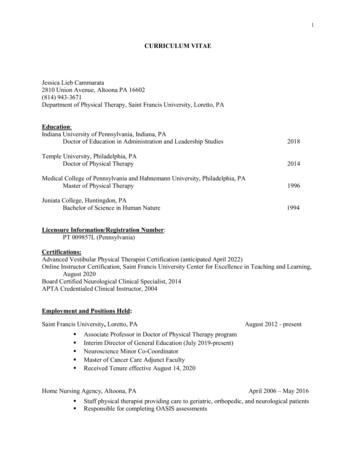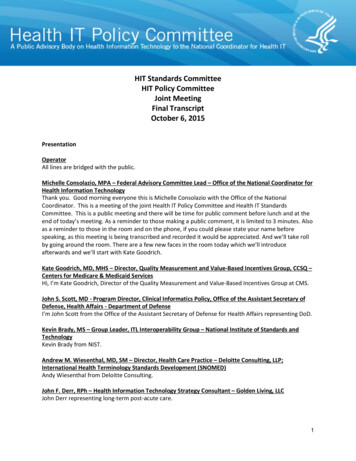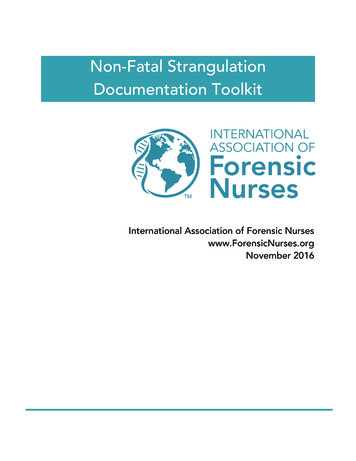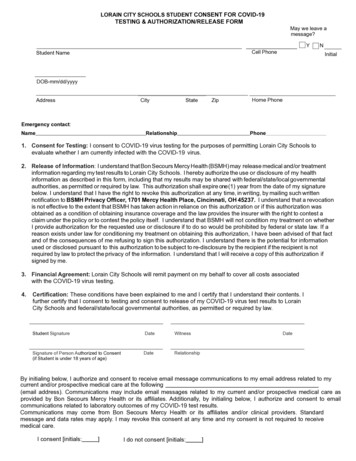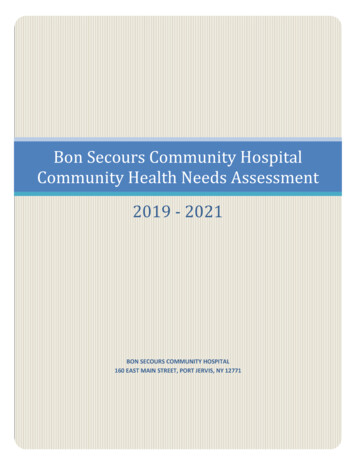
Transcription
Bon Secours Community HospitalCommunity Health Needs Assessment2019 - 2021BON SECOURS COMMUNITY HOSPITAL160 EAST MAIN STREET, PORT JERVIS, NY 12771
Bon Secours Community HospitalA Member of the Westchester Medical Center Health NetworkCommunity Health Needs Assessment 2019-2021EXECUTIVE SUMMARYEvery three years, the New York State Department of Health requires Local Health Departments tosubmit Community Health Improvement Plans (CHIP) and hospitals to submit Community ServicePlans (CSP) which require a thorough Community Health Assessment (CHA) to be completed. Inaddition, the IRS requires all non-profit hospitals to conduct a Community Health NeedsAssessment (CHNA) every three years and to adopt an implementation strategy to meet theidentified community health needs. These assessments and subsequent action plans are meant tomeet several requirements outlined by both New York State public health law and the AffordableCare Act.In recent years, the New York State Department of Health has encouraged local hospitals and healthdepartments to collaborate in the creation of joint CHIP/ CSP documents in order to better servetheir communities. To that end, beginning in 2017, the seven Local Health Departments of the MidHudson Region, including Dutchess, Orange, Putnam, Rockland, Sullivan, Ulster, and WestchesterCounties, along with HealtheConnections (the Regional Health Information Organization coveringthe Hudson Valley of New York) created the Local Health Department Prevention AgendaCollaborative with the goal of creating the first regional Community Health Assessment for theMid-Hudson Region.Bon Secours Community Hospital contributed both funding and staff members to join theCollaborative in contract with Siena College Research Institute (SCRI). SCRI conducted a randomdigit dial regional community health survey to supplement the Regional Community HealthAssessment. In order to gauge the perception of residents surrounding health and resources in theircommunities, responses from 5,372 residents of the Mid-Hudson Region were collected. To furthersupplement the data collected, members of the Collaborative held 12 focus groups with serviceproviders to understand the needs of specific communities and populations, and the barriers theyface to achieving optimal health.As guidance for the Bon Secours Community Hospital Community Health Needs Assessment, alldata gathered through the collaborative CHA process served as the required research and publicinput to identify public health needs and develop action plans necessary to address the specificneeds of the communities we serve.In this report we have identified both internal and community-wide resources that will worktogether to address the identified health needs of our community. The implementation planincluded in this document outlines evidence-based interventions, resources, partners, and intendedoutcomes.If you would like additional information on this CHNA, please email Barbara Demundo@bshsi.orgor call contact Bon Secours Community Hospital at 845-858-7000.
FACILITY DESCRIPTION AND VISIONBon Secours Community Hospital:Bon Secours Community Hospital, a member of the Westchester Medical Center Health Network, isgeographically desirable for residents of New York, New Jersey and Pennsylvania alike; with 122beds for acute care and medical/surgical services, including long-term care and behavioral healthservices. The hospital’s Emergency Department features highly trained physicians, nurses andtechnicians, providing the Tri-State community with a vital, life-saving service.Bon Secours Community Hospital offers the Bariatric Surgery Center of Excellence, a completeprogram dedicated to weight loss surgery, dietary counseling, and support groups to help themorbidly obese patients turn their life around. In addition to acute care services, Bon SecoursCommunity Hospital houses a long term residential facility.As a member of the Bon Secours Charity Health System, the Mission of Bon Secours CommunityHospital is to make visible God’s love and to be Good Help to Those in Need, especially those whoare poor, vulnerable and dying. As a system of caregivers, we commit ourselves to help bringpeople and communities to health and wholeness as part of the healing ministry of Jesus Christ andthe Catholic Church.As a prophetic Catholic Health ministry, we will partner with our communities to create a morehumane world, build health equity and social justice for all, and provide exceptional value for thosewe serve. We will continue to strive to be the leading provider of quality, compassionate andregional community health care services in the Hudson-Delaware Valley.Westchester Medical Center Health Network:The Westchester Medical Center Health Network (WMCHealth) is a 1,700-bed healthcare systemheadquartered in Valhalla, New York, with 10 hospitals on eight campuses spanning 6,200 squaremiles of the Hudson Valley. WMCHealth employs more than 12,000 people and has nearly 3,000attending physicians. From Level 1, Level 2 and Pediatric Trauma Centers, the region’s only acutecare children’s hospital, an academic medical center, several community hospitals, dozens ofspecialized institutes and centers, skilled nursing, assisted living facilities, homecare services andone of the largest mental health systems in New York State, today WMCHealth is the pre-eminentprovider of integrated healthcare in the Hudson Valley.
FACILITY SERVICE AREA AND DESCRIPTION OF COMMUNITYBon Secours Community Hospital is located in the City of Port Jervis, NY which is situated in thewesternmost part of Orange County and bordered by the states of Pennsylvania and New Jersey.Orange County begins approximately 40 miles north of New York City, and is positioned betweenthe Hudson River in the east and the Delaware River in the west, the only county in New York Stateto border both rivers. Ulster and Sullivan Counties border Orange County on the north, andRockland County is located to the south. Orange County is 839 square miles and is a diverse mix ofrural, farmland, suburban, and urban areas.Orange County continues to experience steady population growth, with the 2010 Census indicatingthat Orange County grew 9.2% from 2000 to 2010 to now include 372,813 residents. Thepopulation of the City of Port Jervis is 8828.Based on 2010 U.S. Census population estimates, the median age in Orange County has increasedby more than 2 years since 2007, to 36.6 years; the largest cohort of residents is between the ages of45 and 49. The number of residents ages 65-69 is forecasted to more than double from 2000-2020primarily due to the entry of ‘baby boomers’ into these age ranges.According to the U.S. Census, 11.1% of residents in Orange County were foreign born, with 22.3%of persons over the age of five speaking a language other than English at home.Poverty rates in Orange County vary greatly based on municipality. Poverty rates exceeding 25%for families with related children under 18 are found in Orange County’s three cities (Middletown,Newburgh, and Port Jervis), as well as in the town of Monroe.Bon Secours Charity Health System, of which Bon Secours Community Hospital is a part, hasdefined a service area by zip codes within Orange, Rockland and Sullivan Counties based on thevolume of inpatients receiving care at our acute care facilities.
Bon Secours Charity Health System Service Area Zip Code ockland1096015,357Orange127802,064Bon Secours Charity Health System Service Area Patient Population Demographic Breakdown:Population Demographic CharacteristicsPopulationPercentage ofMid-Hudson RegionPercentage of -Hudson2,329,583N/A11.8NYS19,798,228N/AN/A
Population Stratified by n Stratified by Age 5 years5-19 years20-34 years 65 years35-64 35115.2NYSPopulation Stratified by Race/EthnicityNon-Hispanic .8518,2132.5Population Stratified by Spoken LanguageEnglishLanguage otherthan EnglishSpanishOther IndoEuropeanlanguagesAsian 1,6835.1316,5181.7Mid-HudsonNYS12,924,635 69.4 5,696,716 30.6 2,810,962 15.1 1,617,553Source: U.S. Census Bureau, 2017 American Community Survey 5-year estimates
Population 25 years and son1,570,660NYS13,660,809Population Stratified by Educational AttainmentLess than High SchoolGraduateHigh School GraduateSome college,no degreeAssociate’s degree 5.96,004,93144.0NYSTotal -Hudson811,321NYS7,302,710Households Stratified by Income 10,000 10,000 24,999 25,000 49,999 50,000 74,999 75,000 99,999 95,25911.7333,53241.1516,085 7.1 1,055,677 14.4 1,440,269 19.8 1,160,508 15.9Source: U.S. Census Bureau, 2017 American Community Survey 5-year estimates865,64011.92,264,53131.1NYS
Population Stratified by Veteran StatusCivilian Population18 years and olderCivilian ,900Source: U.S. Census Bureau, 2017 American Community Survey 5-year estimates4.9In New York State, nearly one in four adults, over 3.3 million people, have a disability. Adults witha disability typically have a higher rate of chronic conditions, such as obesity, heart disease, anddiabetes. Structural and societal barriers can limit the ability to participate in work, recreation, andprograms aimed at promoting healthy living for those living with a disability.Various types of disabilities can affect an individual’s quality of life. Types of disability include: Independent living disability – difficulty performing tasks or errands alone, such as visitinga doctor’s office or shopping due to a physical, mental, or emotional condition Cognitive disability – serious difficulty concentrating, remembering, or making decisionsdue to a physical, mental, or emotional condition Self-care disability – difficulty handling tasks, such as dressing or bathing on one’s own Mobility disability – difficulty moving around physically, such as walking or climbing stairs Hearing disability – deafness or serious difficulty hearing Vision disability – blindness or serious difficulty seeing (even when wearing glasses)In the Mid-Hudson Region, Rockland County had the lowest percentage of adults living with adisability and Orange County had the highest percentage of adults living with a self-care disability.Population Stratified by Type of DisabilityAdults Livingwith 6%13.3%3.9%3.7%NYS22.9%3.9%8.7%3.5%Source: NYSDOH Expanded Behavioral Risk Factor Surveillance System, 2018
CHNA METHODOLOGY AND COMMUNITY INPUTBeginning in 2017, Bon Secours Community Hospital entered into a collaborative 7-Countypartnership to create a regional Community Health Assessment (CHA) which was directed byOrange County Epidemiologist Jackie Lawler and representatives from HealtheConnections. Thiscollaborative developed the Regional Community Health Assessment Survey (Appendix A) for thepurposes of creating the CHA and to inform future health improvement efforts in the Mid-HudsonRegion. This survey was designed to include questions to collect information around severalinitiatives and priorities put forward by the New York State Department of Health and the NYSPrevention Agenda 2019 -2024.Survey data collection, analysis, and charting were provided by a team from Siena CollegeResearch Institute. SCRI administered a random digit dial survey by phone which took placebetween April and September of 2018, utilizing both landline and mobile phone numbers to reachrespondents. Results were then weighted by gender, age, race, and region according to the U.S.Census 2010.The Regional Community Health Assessment Survey collected responses from a randomizedsample of over 5,000 Hudson Valley residents however, there were some populations that may nothave been fully accounted for in the survey. Some of these underrepresented populations includethose who are low-income, veterans, seniors, people experiencing homelessness, LGBTQ members,and people with a mental health diagnosis. In order to ensure that the needs of these populationswere met, focus groups were conducted with providers that serve these populations by offeringmental health support, vocational programs, nutritional and educational programs, and family andcommunity support. Before these focus groups took place, a Stakeholder Interview Form (AppendixB) was sent out to these providers in order to supply additional insight around local factorsinfluencing community health. This survey covered several topics, including the populations theproviders serve; the issues that affect health in the communities they serve; barriers to peopleachieving better health; and interventions that are used to address social determinants of health.Throughout the seven counties in the Mid-Hudson Region, 285 surveys were completed by serviceproviders. The answers to the survey varied throughout each county, and these differences wereexpanded upon in the focus groups.The data from the CHA, Stakeholder Interview forms, and focus groups, along with BRFSS data,was presented at an Orange County Community Health Priority Selection Summit in June of 2019,where more than 100 local health/human services providers and CBOs assisted in the selection ofeach county’s CHIP/CSP Focus Areas. At this Summit, 2 Priority Areas for the county were chosenwithin the framework of the 2019-2024 NYS Prevention Agenda.For the purposes of aligning the county’s collective resources to move towards achieving the NYSPrevention Agenda’s goals, the chosen Priority Areas for Orange County are: Prevent Chronic Disease Prevent Communicable DiseaseThe Orange County Health Summary is presented in Appendix C.
IDENTIFIED COMMUNITY HEALTH NEEDSTo provide guidance for the Bon Secours Community Hospital CHNA, a Bon Secours CharityHealth System Community Needs Steering Committee was formed to direct the CHNA process.This committee is responsible for prioritizing community needs and developing hospital-specificimplementation plans to address the identified health needs. Committee members are alsoresponsible for reporting outcomes on a yearly basis for the IRS 990 Schedule H.Bon Secours Charity Health System Community Needs Steering Committee MembersChief Executive Officer: Dr. Mary LeahyCommittee Co-chairs: Barbara Demundo and Jason RashfordExecutive Management Team Members: Sister Susan Evelyn, Patrick SchminckeFinance Representative: David AlbrightPopulation Health Representatives: Craig Dickman, Sapna ShahGood Samaritan Hospital members: Dr. Adrienne Wasserman, Sheila Magee, Claudia WilliamsBon Secours Community Hospital members: Sophie Crawford, Mary Decker, Karen Murphy, TobieWestward MiloneSt. Anthony Community Hospital members: Anita Volpe, Dr. Mark MadisThe Bon Secours Community Hospital 2019 – 2021 CHNA Implementation Plan was developed byusing evidence based interventions as recommended by the NYS Prevention Agenda 2019 – 2024.The overarching strategy of the NYS Prevention Agenda is to implement public health approachesthat improve the health and well-being of entire populations and achieve health equity. This strategyincludes an emphasis on social determinants of health, defined by Healthy People 2020 as theconditions in the environments in which people are born, live, learn, work, play, worship, and agethat affect a wide range of health, functioning, and quality-of-life outcomes and risks. ThePrevention Agenda also forms the important framework through which community health needs areprioritized. The Prevention Agenda’s five Priority Areas serve as the blueprint for state and local action toimprove the health of New Yorkers. As per the NYSDOH requirements, Bon Secours CommunityHospital must choose a minimum of two health goals to address from among the following fivepriority areas: Prevent Chronic Diseases Promote a Healthy and Safe Environment Promote Healthy Women, Infants and Children Promote Well-Being and Prevent Mental and Substance Use Disorders Prevent Communicable DiseasesIn partnership with the Orange County Health Department, Orange County hospitals, and health andhuman service agencies, Bon Secours Community Hospital has chosen the following PreventionAgenda goals to work towards over the next three years Prevent initiation of tobacco use, including combustible tobacco and electronic vapingproducts by youth and young adults Promote tobacco use cessation Increase cancer screening rates for breast, cervical, and colorectal cancers Reduce the annual rate of growth for Sexually Transmitted Infections
COMMUNITY RESOURCESOrange County, NY is resource-rich with an extensive network of health and human serviceagencies located throughout the county. In addition to these agencies, Orange County is home tofive area hospitals, hundreds of medical providers, two-year and four-year colleges, a medicalschool and several large Federally Qualified Health Centers. Throughout the CHA process, thesecommunity partners assisted the Health Department to assess and prioritize health needs and manyhave made commitments to work towards the health goals of the county.Bon Secours Community Hospital has chosen specific Prevention Agenda goals based on ourinternal expertise, resources, and the desire and commitment to improve the health and well-beingof our community members. As no one entity can address all needs, community partners areessential to help achieve the Prevention Agenda goals. As a member of the Joint Membership ofHealth and Community Agencies (JMHCA), Bon Secours Community Hospital works collectivelywith the member agencies to address the diverse needs within the county that the hospital could notdo alone.The following JMHCA member agencies are uniquely positioned to serve as community resourcesto meet both specific and diverse community needs:Access: Supports for LivingLegal Services of the Hudson ValleyAction Toward IndependenceMaternal-Infant Services Network ofOrange/Sullivan/UlsterAlcoholism & Drug Abuse Council ofOrange CountyThe ARC of Orange County, NYSARC, Inc.Mental Health Association of OrangeCounty, Inc.Catholic Charities of Orange and SullivanMiddletown Community Health CenterCornerstone Family HealthcareNAMI OrangeCPI/Epilepsy Society of Southern New YorkOrange County Department of MentalHealthCRVIDispute Resolution CenterEzras Choilim Health CenterFarmworkers Community Corp.Highland Rehabilitation and Nursing CenterHONORehg, Inc.Independent Living, Inc.InspireJewish Family Service of Orange CountyOrange County Housing ConsortiumPeople, Inc.RECAP, Inc.Rehabilitation Support Services, Inc.Restorative Management Corp.Safe Harbors of the Hudson, Inc.Safe Homes of Orange CountyUnited Way of the Dutchess-Orange RegionYouth Advocate Program
EVALUATION OF IMPACT FROM PREVIOUS CHNABon Secours Community Hospital’s 2016 – 2018 CHNA had the following impact:Goal:Increase Access to High- Quality Chronic Disease Preventive Care and Management in Clinical andCommunity SettingsImpact: BSCH completed onboarding use of Healthify to improve care coordination efforts with CBOs Construction of Medical Village began in Dec. 2018. Temporary ED will allow for a completerenovation of the current ED to include co-located Behavioral Health Services and an Observation unit. Investment in IT and internal BSCH Action Team to actively engage in the NYS MAX Series Project toreduce re-admission and provide steering to System work teams. BSCH has implemented Post Discharge Transition of Care 30 Day Telephonic Follow Up Program toreduce re-admissions. EHRs and data sharing services are utilized to provide patients with contact information of communitypartners to assist with access to preventive care and community resources. Ambulatory Care Managers work with Medical Group patients to ensure compliance with dischargeinstructions and to remove barriers. BSCH continues to utilize the Post Discharge Transition of Care Telephonic Follow Up Program toimprove outcomes and reduce readmissions for post-discharge patients.Goal:Promote Mental, Emotional and Behavioral Well-Being in CommunitiesImpact: Behavioral Health Integration Coordinator is responsible for behavioral health integration into primarycare by conducting clinical assessments and evaluations and delivering treatment services in individualand group formats. This role is designed to enhance screening, treatment and engagement within thispopulation. Treatment and therapy is provided based upon the treatment plan developed by the multidisciplinarytreatment team (PCP/LMHC/collaborating psychiatrist) and in partnership with the adult primary carepractice. The Behavioral Health Integration Coordinator works with patients and their families/caregivers increating effective psychiatric treatment plans and consults with community resources involved inpatient’s treatment plan. BSCH has continued the contract in with Access: Supports for Living to assist with care coordinationand reduce re-admissions post Behavioral Health inpatient discharge. Peers are utilized to bridge gapduring first 48 hours after discharge to help with medication pickup, connecting with provider and goingto first appointment with provider.
BON SECOURS COMMUNITY HOSPITAL2019 – 2021 COMMUNITY HEALTH NEEDS ASSESSMENTIMPLEMENTATION PLANNYS PREVENTION AGENDA PRIORITY AREA: PREVENT CHRONIC DISEASESFOCUS AREA 3: Tobacco PreventionPREVENTION AGENDA GOALS3.1 Prevent initiation of tobacco use, including combustible tobacco and electronic vaping products byyouth and young adults3.2: Promote tobacco use cessation, especially among populations disproportionately affected by tobaccouse including: low SES; frequent mental distress/substance use disorder; and disabilityOBJECTIVES: By December 31, 2021, decrease the prevalence of lifetime vaping product use by high schoolstudents by 20% from 25% to 22.5% and decrease the current tobacco use by high school students by 20%from 6.3% to 5.0%. (Data source: Orange County Youth Survey, 2016)EVIDENCE BASED INTERVENTIONS3.1.2: Use media and health communications to highlight the dangers of tobacco use and reshape socialnorms (Source: The Community Guide)3.2.4: Promote Medicaid benefits for tobacco cessation services and free cessation classes available in OrangeCounty particularly among target populations in Middletown and Port Jervis (Source: CDC)DISPARITIES ADDRESSED: Adults with low SES, Adults living with a disabilityActivitiesTimeframeIntermediateLevel EvaluationMeasuresNumber of postersdistributedCreate a mediacampaign includingposters andadvertisementsthrough the s on theeffects of smokingand vaping to highschool age studentsJanuary2019December2021Number ofpresentations atschools andcommunity eventsMedicaid benefitspromotion to targetpopulationJanuary2020December2021Number ofpersonscompletingFreedom fromSmoking programHost Freedom fromSmoking ClassesInternal StaffandResourcesBon ntBSCHNursing rtnersOrange CountyHealth Dept.,ADAC, CatholicCharities ofOrange, Ulsterand SullivanCountiesPort Jervisschool districts,Operation PJPride, OrangeCounty HealthDept.BSCHOrange CountyNursing andHealth Dept.,RespiratoryAccess:departments, Supports forBSCHSLiving, Office forCommunitythe ased knowledgeamong youth regardingthe dangers of vaping andcombustible tobaccoDecrease in number ofhigh school age studentswho beginsmoking/vapingIncreased number ofadults referred fortobacco cessationIncreased number ofindividuals who quitsmoking
BON SECOURS COMMUNITY HOSPITAL2019 – 2021 COMMUNITY HEALTH NEEDS ASSESSMENTIMPLEMENTATION PLANNYS PREVENTION AGENDA PRIORITY AREA: PREVENT CHRONIC DISEASESFOCUS AREA 4: Preventive Care and ManagementPREVENTION AGENDA GOAL 4.1: Increase cancer screening rates for breast, cervical, and colorectal cancers,especially among disparate populations in the cities of Newburgh, Middletown and Port JervisOBJECTIVE: By 12/31/2021, increase % of adults receiving breast cancer, cervical, and colorectal cancerscreenings based on the most recent screening guidelines by 5%. (Baselines: 75.9% Breast Cancer Screening;76.1% Cervical Cancer Screening and 68.5% Colorectal Cancer Screening; Data Source: BRFSS, 2016)EVIDENCE BASED INTERVENTIONS:4.1.2: Conduct one-on-one (by phone or in person) and group education (presentation or other interactivesession) in a church, home, senior center of other setting (Source: The Community Guide)4.1.3: Use small media and health communications to build public awareness and demand (Source: TheCommunity Guide)DISPARITIES ADDRESSED: Low SES concentrated in areas with high racial/ethnic minorities; Education levelActivitiesConductcommunityeducationssessions aboutneed for cancerscreenings atlocal libraries,senior centers,and mediate LevelEvaluationMeasuresInternal StaffandResourcesNumber ofindividuals reachedthrough one-on-oneor group educationthat were referredto health providersfor cancerscreeningsBon unityEngagementChange in awarenessof the importance ofcancer screenings asa BSMG providersOrange CountyHealth Dept.IntendedOutcome/Product/ResultChange in awareness ofneed for cancer screeningsas part of preventative careCompliance with screeningguidelines amongindividuals that werereached through one-onone or group educationIncrease in the percentageof adults receiving cancerscreenings
Developconsistentmessage acrossall entities toincrease cancerscreeningsduringawarenessmonths forbreast, cervicaland colorectalcancersJune 2019March 2020Evaluate howpatients havefound cancerscreeningsthroughsurveys (i.e.newspaper,mailings, flyers,word of mouth,social media orother)December2019December2020Number and type oflocations whereposters ent,BSMGOrange CountyHealth Dept.Number ofBSCHScommunityCommunitymembers surveyedEngagementat community eventsOrange CountyHealth Dept.Number of callsreceived aboutscreening due tocampaignPercentages of howpatients foundcancer screenings bymedia typeChange in knowledge andawareness of need forcancer screeningsOrange CountyCancerPrevention workgroupOrange CountyCancerPrevention workgroupIncreased knowledge ofhow patients are learningabout cancer screeningservicesAbility to target areas andmarkets for greater impactand community awareness
BON SECOURS COMMUNITY HOSPITAL2019 – 2021 COMMUNITY HEALTH NEEDS ASSESSMENTIMPLEMENTATION PLANNYS PREVENTION AGENDA PRIORITY AREA: PREVENT COMMUNICABLE DISEASESFOCUS AREA 3: Sexually Transmitted Infections (STIs)PREVENTION AGENDA GOAL 3.1: Reduce the annual rate of growth for STIsOBJECTIVE #1: By December 31, 2021, reduce the annual rate of growth of chlamydia by 50% from 2.17% to1.09%. (Baseline Data: 2016-2018 average 3-year percent change)OBJECTIVE #2: By December 31, 2021, reduce the annual growth rate for gonorrhea by 50% from 4.0 to 2.0%(Baseline Data: 2016-2018 average 3-year percent change)OBJECTIVE #3: By December 31, 2021, reduce the annual growth rate for early syphilis by 50% from 20% to10% (Baseline Data: 2016-2018 average 3-year percent change)(Data source: NYSDOH Communicable Disease Electronic Surveillance System (CDESS), 2016-2018)EVIDENCE BASED INTERVENTION 3.1.2: Increase STI testing and treatment (Source: CDC)DISPARITY ADDRESSED: People with low education level and/or low SESActivitiesOCDOH toprovide inpersoneducation tohospitalEmergencyDepartmentMedical an
Bon Secours Community Hospital: Bon Secours Community Hospital, a member of the Westchester Medical Center Health Network, is geographically desirable for residents of New York, New Jersey and Pennsylvania alike; with 122 beds for acute care and medical/surgical services, including long-term care and behavioral health services.
